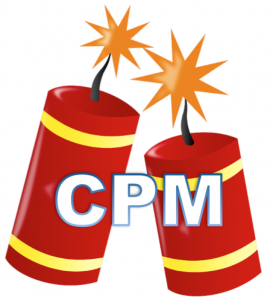 The year was 2008. Social media was just ramping up. Twitter was an infant and people were still wondering why Google bought YouTube. MySpace was starting to wither under News Corp and Facebook was on the rise to supplant it. Read more
The year was 2008. Social media was just ramping up. Twitter was an infant and people were still wondering why Google bought YouTube. MySpace was starting to wither under News Corp and Facebook was on the rise to supplant it. Read more
Why I Built Scrypter
Digital Advertising Predictions for 2015
The marketing department at Signal asked several people at the company to make digital advertising predictions for 2015. With their blessing, I’m publishing my predictions right here. I also added a couple of additional topics at the bottom.
The Ecosystem
2015 will be a big year for IPOs and consolidation. Startups will form in nascent categories, but not so much in established ones. Luma will produce a new set of Lumascapes to accommodate the rise of new categories. This is hardly a shocking prediction.
Cross-Channel
Cross-channel will be the rule in 2015. Companies with a single channel solution will be the exception (and the Dodo).
Programmatic
We’ll see the rise of the Meta-DSP where Agency systems will be plugging into DSP stacks via APIs. Smarter systems will be able to segment users across DSP buying systems and regain control of Frequency and Reach.
Native advertising
Native Normalization: Native ads will begin to follow responsive design techniques. “Standardized Native Ads” will become the biggest oxymoron of 2015. Native ad specifications are already working their way into the OpenRTB API Specification. The road to standardization is very short from that point on. Read more
Data Leakage is still a concern among publishers
Does connecting website X to an RTB exchange enable all potential bidders to track all traffic and users in such website X?
In other words, can bidders build full user behavior history of what the users do inside website X on a pageview by pageview basis?
This question was asked on quora, below is my answer.
The short answer is yes. Connecting your site to an SSP, or RTB exchange opens your inventory and your users up to being tracked by as many DSP buying platforms as are enabled on your inventory.
Data Leakage
 Every impression is put out to bid, along with that a user identifier is passed. This gives the buyers the information they need to make a decision, “Do they buy or not?” If the buying platform decides to track the user and build a profile on that user’s behavior, there’s little the publisher can do from a technology perspective. The shorthand for this misappropriation of information is Data Leakage.
Every impression is put out to bid, along with that a user identifier is passed. This gives the buyers the information they need to make a decision, “Do they buy or not?” If the buying platform decides to track the user and build a profile on that user’s behavior, there’s little the publisher can do from a technology perspective. The shorthand for this misappropriation of information is Data Leakage.
Sell side platforms and exchanges generally have contracts that restrict buy side platforms (DSPs) from taking advantage of this situation. Data leakage was a serious concern in the early days of RTB and publishers were quick to ask for assurances from their SSP partners.
It’s a two-sided issue, though. The publisher is concerned about their user population being profiled, tracked and then purchased on cheaper inventory. The buyers have concerns about their advertiser intent data being tracked. The publisher can use this data to raise prices on the inventory or cut the buy side platform out of the deal.
Private Exchange
Both buy side platform companies and sell side platform companies are striving to introduce more controls over inventory and ad deals in RTB. The concern over data leakage has largely been subdued. Higher valued inventory and advertising is being sold privately using enhancements made on the RTB ecosystem. These private exchanges limit the exposure of high-value inventory to a subset of buyers and vice-versa.
Alternative to the CPM
Online advertising transactions are all CPM based. You might think my wild assertion is out of line. You might think you’re buying ads on a CPC or a CPA basis. But when a publisher is looking to sell ad inventory, they’re thinking about the CPM. “How many dollars can I get for every thousand ad views?” And when that CPA deal or that CPC deal comes in the publisher’s doing the math to convert that number into a CPM.
 For a CPA deal they’re estimating how many acquisitions they can send to the buyer for every thousand ad views. For CPC, how many clicks per thousand ad views. They’re boiling it down to a CPM because that’s how they can compare the deals. It works like this all the way up and down the funnel.
For a CPA deal they’re estimating how many acquisitions they can send to the buyer for every thousand ad views. For CPC, how many clicks per thousand ad views. They’re boiling it down to a CPM because that’s how they can compare the deals. It works like this all the way up and down the funnel.
The CPM has been around for a long time. With the advent of the RTB auction model, the CPM is very dynamic. Each impression up for auction is individually valued based on countless bits of information about the user, the page, the size, the date, the historical performance and a variety of other variables. Even though a separate auction is run for each impression, the bid prices are still in the form of a CPM. It’s in our blood. It is the end result of normalizing the value of an ad impression so that it can be compared to its peers.
Some Problems
I want to point out a couple of problems with the CPM. First and foremost, it’s a single number. This aspect causes a couple of secondary problems that put the buyers at risk. One of the big ones is that there’s no guarantee that the ad will actually show on the page. Steps have been taken to address this by several companies. The result of this problem is a topic near and dear to my heart: discrepancy. Read more
Buying the (Blueberry) Farm
One of the more interesting decisions I’ve made was buying into the blueberry farm. It came about “innocently” enough. My brother and father conspired to pitch an investment opportunity in the form of blueberries.
From Email to Farm

By 2006 the business was humming along. We had several clients and were expanding into other opportunities. There was a substantial surplus of cash that we opted to take out of the business. This allowed me to pursue other ventures, like farming. Internet technology and farming go hand in hand, right? Read more





